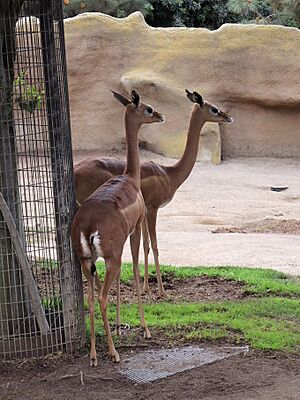Gerenuk facts for kids
Quick facts for kids Gerenuk |
|
|---|---|
 |
|
| Male | |
 |
|
| Two female gerenuk in the San Diego Zoo | |
| Conservation status | |
| Scientific classification | |
| Genus: |
Litocranius
|
| Species: |
walleri
|
 |
|
| distribution of gerenuk (2008) | |
The gerenuk (pronounced GARE-uh-nook), also called the giraffe gazelle, is a unique antelope found in parts of East Africa. It is known for its very long, thin neck and legs. The gerenuk is the only member of its group, called Litocranius.
A naturalist named Victor Brooke first described the gerenuk in 1879. This antelope can be 80–105 centimetres (2 feet 7 inches – 3 feet 5 inches) tall and weighs between 18 and 52 kilograms (40 and 115 pounds). Its smooth coat has two main colors: a reddish-brown back (like a "saddle") and lighter, fawn-colored sides. Only male gerenuks have horns. These horns are shaped like a lyre (a U-shaped musical instrument) and can be 25–44 cm (10–17+1⁄2 in) long.
Contents
About the Gerenuk's Name
The gerenuk was first described by Victor Brooke in 1879. He named it Gazella walleri after Gerald Waller, who helped get the animal specimens. The animals came from the coast near the Juba River in southern Somalia.
In 1886, a scientist named Franz Friedrich Kohl suggested a new group, or genus, for the gerenuk, calling it Litocranius. The common name "gerenuk" comes from the Somali language word gáránúug. People also call it the "giraffe gazelle" because of its long neck, which looks a bit like a giraffe's.
Scientists have suggested there are two types of gerenuks:
- The Northern gerenuk (L. w. sclateri) found in parts of Somalia, Ethiopia, and Djibouti.
- The Southern gerenuk (L. w. walleri) found in Tanzania, Kenya, and Somalia.
What Does a Gerenuk Look Like?
Gerenuks are tall, slender antelopes that look a bit like gazelles. They have a long, thin neck and legs, a flat, wedge-shaped head, and large, round eyes.
Male gerenuks are usually 89–105 cm (35–41+1⁄2 in) tall. Females are a bit shorter, about 80–100 cm (31–39 in). Their body length is typically between 140 and 160 cm (55 and 63 in). Males weigh between 31 and 52 kg (68 and 115 lb), while females are lighter, weighing 28–45 kg (62–99 lb). This difference in size between males and females is called "sexual dimorphism." The gerenuk's tail is 25–35 cm (10–14 in) long and has a black tuft at the end.
Their smooth coat has two clear colors. The back is reddish-brown, and the sides are lighter, from fawn to buff. Their belly and the insides of their legs are cream-colored. White fur surrounds their eyes and mouth. Female gerenuks have a dark patch on the top of their head.
Only male gerenuks have horns. These horns are S-shaped, curving backward and then slightly forward. They can measure 25–44 cm (10–17+1⁄2 in).
Gerenuks look similar to another animal called the dibatag, which lives in the same areas. Both have long necks, two-toned coats, and strong horns (on males). However, gerenuks have a longer, heavier neck and a shorter tail than dibatags.
Gerenuk Behavior and Habitat
The gerenuk is a diurnal animal, meaning it is active mostly during the day. However, it often rests in the shade during the hottest part of the afternoon. Most of its day is spent looking for and eating food. Female gerenuks seem to spend more time eating than males.
Gerenuks live in small groups of two to six animals. These groups usually have members of the same sex. Female groups might also include young gerenuks. Some male gerenuks live alone.
Gerenuks do not fight or travel much. This helps them save energy for finding food. Both males and females have a "home range" of about 3–6 km2 (1–2+1⁄2 sq mi). These areas can sometimes overlap. Male gerenuks mark their home ranges with a special scent from glands near their eyes. They also guard these areas, so they are called "territories." Older gerenuks tend to stay in one place more.
What Do Gerenuks Eat?
Gerenuks are mainly "browsers," which means they eat leaves, shoots, herbs, flowers, and fruits from bushes and trees. They are very good at reaching high branches and twigs. They can stand up on their hind legs and stretch their long necks to reach food over 2 m (6 ft 7 in) off the ground! This helps them get food that other gazelles cannot reach.
They often eat Acacia trees when they are available. During dry seasons, they eat evergreen plants. Their pointed mouths help them pick leaves from thorny plants. Gerenuks do not need to drink water often because they get most of the water they need from the plants they eat.
The main animals that hunt gerenuks are African wild dogs, cheetahs, hyenas, lions, and leopards.
Gerenuk Reproduction and Life Cycle
Gerenuks can have babies throughout the year. Female gerenuks can start having babies when they are about one year old. Males are ready to reproduce at about 1.5 years old. However, in the wild, males might not successfully have babies until they are about 3.5 years old and have their own territory.
The mother gerenuk carries her baby for about seven months. Usually, only one baby is born at a time, weighing about 3 kg (7 lb).
In 2010, baby gerenuks were born using artificial insemination for the first time at White Oak Conservation in Yulee, Florida. Four female calves were born. One of these females later had her own babies through artificial insemination, creating a second generation.
Gerenuks can live for thirteen years or more in zoos and at least eight years in the wild.
Images for kids








